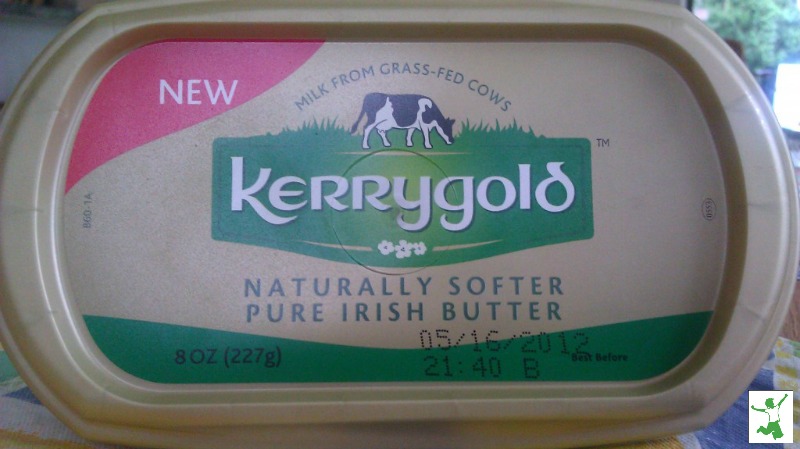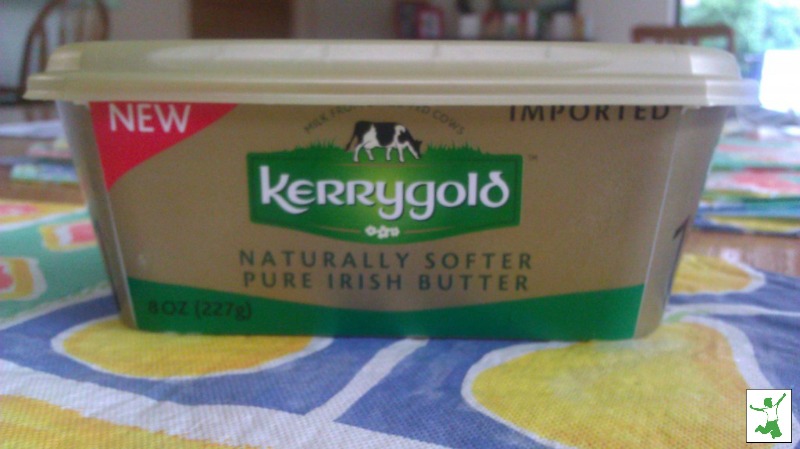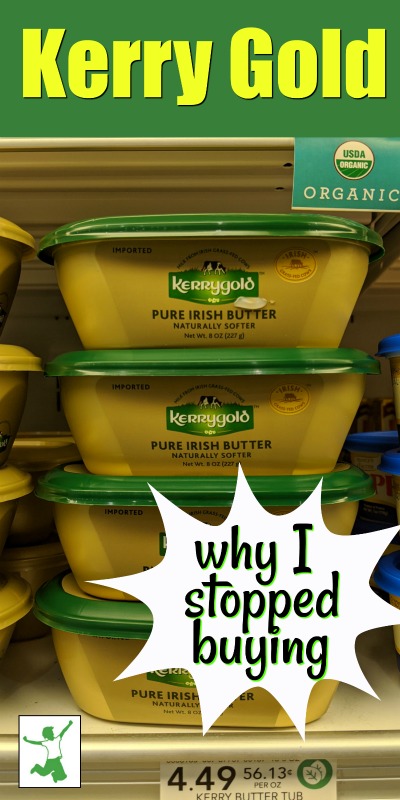Table of Contents[Hide][Show]
Kerrygold is marketed as grass-fed and all-natural, but the tub butter has concerning ingredients, dangers and marketing ploys to consider before buying.

Kerrygold, without question, is probably one of the best store butters you can buy. I myself have been using it for years for cooking.
The milk is from grass-fed cows and even though the cream used to make Kerrygold Butter is pasteurized, it is the best choice available to most folks who do not have access to raw butter from a small farm or who simply don’t want to use their precious raw butter for cooking.
I also know that many of you out there use Kerrygold too. When I conducted a Butter Poll on this blog awhile back, by far the most used butter (out of 1,500 or so total votes) was Kerrygold which received way more votes than even Organic Valley butter.
So what’s the problem?
My husband brought home the “new” Kerrygold butter the other day. On the surface, it looked fine. Nowhere on the outside of the package was there any indication that there was a problem with this butter. Here’s what it looks like.

I got suspicious with the “new” label, however. There’s nothing “new” about butter. That’s what I like about it after all!
Another tip-off that there was a problem lurking was the proclamation on the label that this “New Kerrygold” was “naturally softer”.
When I first saw the “naturally softer” words, I thought that meant that the butter was whipped and hence more spreadable. I don’t know about you, but I don’t want air whipped into my butter. This is a surefire way to get less product and get charged the same price for the privilege if you know what I mean.
I made a mental note to tell my husband not to buy this butter again because it was whipped and not as good a value.
But then, it got way worse…
Is Kerrygold Butter Grass-fed?
I took off the lid to the new Kerrygold package and saw the following words:

I had become a victim of the Big Fast One!
Kerrygold is stealthily selling LOWFAT butter and guess what? You get to pay the same price for the cheaper quality!
NOWHERE on the outside of the label did it say that the butter was low-fat. The ingredients said simply: pasteurized cream and salt the same as the commercialized Amish butter at the supermarket.
I daresay that this marketing ploy will be fooling a lot of folks who desire to buy full-fat grass-fed butter.
It seems that some butter brands have adopted what companies making substitutes for butter have been doing for years.
I have become very tuned in to these labeling tricks and manufacturer games over the years. When it comes to packaging, I double-check the ingredients along with the manufacturing processes every few months. This is even for products that I’ve been buying for years.
But how many people really do this?
Ingredient Bait and Switch
You NEED to be doing this!
Manufacturers are changing ingredients and packaging all the time! The primary intent of these “improvements” is to increase product sales and profitability. Your health is, sadly, of little to no concern in the grand scheme of things.
Reducing the fat content in its butter will skyrocket profits for Kerrygold as they will make the same per unit for the butter and yet be able to sell the skimmed cream to other companies to make ice cream or whatnot thereby increasing revenue substantially.
If you buy Kerrygold, I’m not telling you to stop buying it. I’m only telling you to beware of this new packaging nonsense and be sure what you buy is what you intend: full-fat butter!
By the way, if you are wondering why I love full-fat butter, you might want to educate yourself on the low-fat scam by learning about the history of butter vs margarine in the United States.
As for me, I will be returning this product to the store for a full refund. It is falsely advertised after all. I had no way of knowing it was a low-fat product until I opened it.
Manufacturer Response
I received this email from Kerrygold following the widespread sharing of this article. I find it very hard to believe that my blog suddenly brought this packaging error to their attention.
Do they have NO ONE on the production line in charge of quality control? This was not a difficult problem to identify. Could we have a bit of spin going on here? Perhaps so.
Dear Sarah,
Your blog has brought to our attention a packaging error of which we were unaware. While Kerrygold does sell a Reduced Fat & Sodium Butter the pack you show on your blog is 100% full fat butter which has been packed with the incorrect inner seal. There is no deliberate intent on our part to mislead our valued consumers or to misrepresent our product although we regret the confusion this is clearly creating.
We are working to identify how much product has been released into the market with the incorrect packaging so that we can replace it as soon as possible. In the meantime we would appreciate your assistance in clarifying the misunderstanding to your readers. We would love to provide further clarity — our email is [email protected] — and we are happy to answer any specific questions you and your readers may have in relation to the product.
With thanks & regards,
The Kerrygold Team
Why I No Longer Buy Kerrygold
I wanted to let all of you know that I no longer buy even the traditional Kerrygold brick butter in foil packaging. Why? A good friend visited Ireland and traveled extensively to a number of grass-based dairy farms.
This credible source told me that while the cows that provide cream for the Kerrygold butter are definitely on pasture and hence “grass-fed”, they receive supplemental GMO animal feed as well especially during the winter months. The local community and citizenry in Ireland concur and will tell you as much if you are in the area.
So, the word on the street is that Kerrygold is not legitimately pastured either.
Butter from cows that get GMO feed introduces the very real possibility of Roundup residue in the butter.
Thanks but no thanks!
While I have not been able to confirm this story 100%, I trusted the credibility of the information enough to permanently switch to another brand (I currently use this one).
I use this butter for cooking in addition to the homemade pastured raw butter I make for non-cooking purposes.
I also no longer recommend Kerry Gold in my Shopping Guide.
What about Organic Valley butter as an alternative to Kerry Gold? While I am not happy about Organic Valley’s policy that disallows member farmers to sell raw milk on the side to their community (treating them more like medieval serfs than the independent business owners that they are), I find this less onerous than deceptively feeding animals GMO feed without clearly informing the end consumer.









@Winni I don’t agree. I think the post is very valuable because folks who bought mislabeled packages are now aware and can return them. I am still returning mine. I am now skeptical of kerrygold’s motivations entirely. They are trying to pander to the lowfat market. By the way, how do you know what they say is even true? Companies lie all the time to protect profits. Is this CYA behavior? The post stands as it is and folks can decide for themselves.
interesting! I’ll stick to the foil anyway as I transfer it into my awesome polish pottery butter dish once opening.
I’m happy your blog brought this to their attention.
I think that these kind of errors happen all the time and it isn’t that big of a deal. A little fact checking would have prevented this entire misunderstanding. I love your blog, but I am rather disappointed in this shotgun response. You have a large readership and in my opinion, the responsibility to verify what you print. I don’t think it is spin, i think we’ve become overly cynical. Just looking at the nutrition label and maybe checking their website would have clarified things. You just got faulty packaging and it’s too bad that you are going to turn a bunch of people against a good brand simply because of a mistake. Like it or not, you are influential. I don’t mean to sound harsh, but I know that people will just take your word for it even if unverified, and that isn’t fair.
Yes! I couldn’t agree more. Jumping to conclusions only hurts both sides in the end…
Maybe a bit of spin going on? Maybe, maybe not. I’m still returning my tub of reduced fat butter even if they say its full fat.
@Winnie I have added that email from Kerrygold to the post. For the record, I find it very hard to believe that my little blog identified a production problem that they were unaware of given that the company prides itself on quality control of its product.
http://t.co/sdhu7yk7
I see this question was mentioned already, but I did not see a good reply. How in the world do you reduce the fat in butter, since butter is fat!!! Even if you start with low-fat milk, you would just get a lot less butter. So their label inside the container makes no sense to me.
If it is done by whipping so the product contains more air, wouldn’t more whipped butter be needed to maintain the same weight as non-whipped butter??? Additionally that would throw off the proportions of most recipes.
Am I missing something?
I have a hard time faulting a business for attempting to maximize profit. I do wonder at the decision they’ve made here, which is to decrease the quality of the product – when the more “gourmet” quality of the product is what serves it so well in the market. If it was the big box brand, conventional supermarket, 50c/Lb. after coupons, mass produced stuff, it would make sense business-wise to cut the quality as low as necessary to maximize profit. But for a brand like Kerrygold, I wonder if they are trying to cater to that remnant market of “gourmet”, organic/grass-fed, low-fat, semi-vegetarian demographic (the kind that seems to dictate every Whole Foods Market publication). If that’s the case, they are either unaware that they have a sturdy following that will be lost in this switch or they believe that remnant market is stronger and they “need” those customers more than the “real food” families, gourmet foodies and other cuisine connoisseurs. Only time will tell if they regret this move based on economic repercussions and minimize or eliminate this new product line. I’m curious about how many of the “low fat” crowd are eagerly seeking grass-fed dairy that fits their low-fat criteria, and what they’ll pay for it.
As to the responses here, I completely understand being appalled at the deceptiveness of the hidden information and being offended at the miserly minded attempt they have made here with the decrease in quality not reflected in price. As for their profits “skyrocketing”, I’m doubtful that even they anticipate that (unless they’ve had a very charming consultant convince them of it), but I can’t imagine becoming to attached to a brand that you feel personally betrayed (collectively as it may be) when the company attempts to maximize their profit. I don’t meant to imply that any individual indicated an especially irrational attitude, but the “mob mentality” tends to get out of hand in situations like this with little effectiveness. In my limited observational experience (and I’ve contributed my share to it in similar situations past!)!
I stopped buying Kerrygold when they started selling it at Costco.
I’m just curious why this matters? It makes there product more affordable for people like me who want to eat real, whole foods, but can’t pay $6-$8 for one small 6oz brick at the regular grocery store.